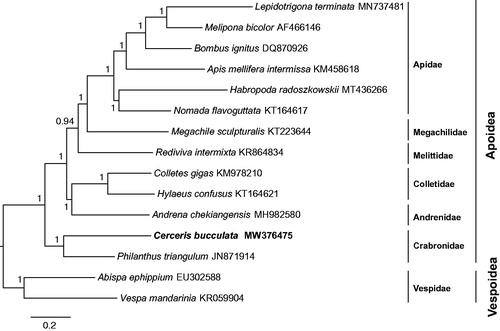Abstract
The complete mitochondrial genome of the Cerceris bucculata (A. Costa, 1860) (Hymenoptera: Crabronidae) was obtained via next-generation sequencing. This mitochondrial genome is 16178 bp in length with 37 classical eukaryotic mitochondrial genes and an A + T-rich region. All the 13 PCGs begin with typical ATN codons. Among them, eleven PCG genes terminate with TAA, two with T––. All of the 22 tRNA genes, ranging from 58 to 72 bp with typical cloverleaf structure except for trnS1, whose dihydrouridine (DHU) arm forms a simple loop. Phylogenetic analysis highly supported Crabronidae shown as sister group of anthophila bees.
Genus Cerceris Latreille (1802) belongs to subfamily Philanthinae (Hymenoptera: Crabronidae). Until now, a total of 870 species and 168 sub-species have been described (Li and Ma Citation2016). Genus Cerceris is a group of predatory insects that feed on hymenopteran and coleopteran species. Here, we sequenced the complete mitochondrial genome of Cerceris bucculata (A. Costa, 1860), which was collected by Malaise trap in Xi Guai Chang Village (36.5851°N, 118.3430°E), Qingzhou City, Shandong Province, China. The sample used in the experiment are now stored in the the Institute of Zoology, Chinese Academy of Sciences (Accession number: NF20001, Email contact: [email protected]) and the GenBank accession No. is MW376475.
The total mitochondrial genome of C. bucculata was obtained through next-generation sequencing. The extracted DNA mixture were applied for library constructing by the usage of Illumina TruSeq@ DNA PCR-Free HT Kit, and sequenced by the platform of llumina HiSeq sequencer (150 bp pared-end). The mitochondrial genome of C. bucculata was assembled based on Illumina short reads with MitoZ v2.3 (Meng et al. Citation2019). The whole mitochondrial genome annotation was annotated by Mitos WebServer (http://mitos2.bioinf.uni-leipzig.de/index.py) under the invertebrate mitochondrial code (Bernt et al. Citation2013). Transfer RNA (tRNA) genes were confirmed by online ARWEN (http://130.235.46.10/ARWEN/) (Laslett and Canback Citation2008). Pyhylosuite was used for the data processing, including sequences alignment, sequences concatenation and the best optimal model prediction (Zhang et al. Citation2020).
The complete mitogenome sequence of C. bucculata was 16178 in length with A + T content of 83.4%. It consists of 13 protein-coding genes (PCGs), 22 transfer RNAs (tRNAs), two ribosomal RNAs (rRNAs) and a putative control region (CR). All 13 PCGs were initiated by typical ATN codons (four ATT, five ATG and four ATA). Eleven genes use TAA as terminal stop and two genes stop with T––. All of the 22 tRNA genes, ranging from 58 to 72 bp, have a typical cloverleaf structure except for trnS1, whose dihydrouridine (DHU) arm forms a simple loop. The absence of the DHU arm in trnS1 was found in the mitochondrial genomes existed in most insects (Wolstenholme Citation1992). The control region was 1154 bp long and 81.2% A + T content. The rrnL and rrnS genes were 1319 and 809 bp, A + T content of them were 85.2% and 86.5%, respectively.
In order to explore the phylogeny of C. bucculata, 15 complete mitogenome sequences were downloaded from GenBank, including two outgroups from family Vespidae (Abispa ephippium and Vespa mandarinia). The phylogenetic tree was constructed using MrBayes (Ronquist et al. Citation2012) based on 13 concatenated PCGs (). Within superfamily Apoidea, Crabronidae shown a sister relationship with anthophila bees (Apidae, Megachilidae, Melittidae, Colletidae and Andrenidae) (Branstetter et al. Citation2017). Within Crabronidae, C. bucculata shown a sister relationship with Philanthus triangulum, in which both genera belong to the subfamily Philanthinae.
Disclosure statement
No potential conflict of interest was reported by the authors. The authors alone are responsible for the content and writing of the paper, and report no conflicts of interest.
Data availability statement
The genome sequence data that support the findings of this study are openly available in GenBank of NCBI at (https://www.ncbi.nlm.nih.gov/) under the accession no. MW376475. The associated BioProject, SRA, and Bio-Sample numbers are PRJNA713942, SRR13963372, and SAMN18275438 respectively.
Additional information
Funding
References
- Bernt M, Donath A, Juhling F, Externbrink F, Florentz C, Fritzsch G, Pütz J, Middendorf M, Stadler PF. 2013. MITOS: improved de novo metazoan mitochondrial genome annotation. Mol Phylogenet Evol. 69(2):313–319.
- Branstetter MG, Danforth BN, Pitts JP, Faircloth BC, Ward PS, Buffington ML, Gates MW, Kula RR, Brady SG. 2017. Phylogenomic insights into the evolution of stinging wasps and the origins of ants and bees. Curr Biol. 27(7):1019–1025.
- Laslett D, Canback B. 2008. ARWEN: a program to detect tRNA genes in metazoan mitochondrial nucleotide sequences. Bioinformatics. 24(2):172–175.
- Li XL, Ma L. 2016. A new species of genus Cerceris (Hymenoptera: Crabronidae) from Yunnan, China. Southwest China J Agric Sci. 29(12):3015–3018.
- Meng GL, Li YY, Yang CT, Liu SL. 2019. MitoZ: a toolkit for animal mitochondrial genome assembly, annotation and visualization. Nucleic Acids Res. 47(11):e63.
- Ronquist F, Teslenko M, van der Mark P, Ayres DL, Darling A, Hohna S, Larget B, Liu L, Suchard MA, Huelsenbeck JP. 2012. MrBayes 3.2: efficient Bayesian phylogenetic inference and model choice across a large model space. Syst Biol. 61(3):539–542.
- Wolstenholme DR. 1992. Genetic novelties in mitochondrial genomes of multicellular animals. Curr Opin Genet Dev. 2(6):918–925.
- Zhang D, Gao F, Jakovlić I, Zou H, Zhang J, Li WX, Wang GT. 2020. PhyloSuite: an integrated and scalable desktop platform for streamlined molecular sequence data management and evolutionary phylogenetics studies. Mol Ecol Resour. 20(1):348–355.

